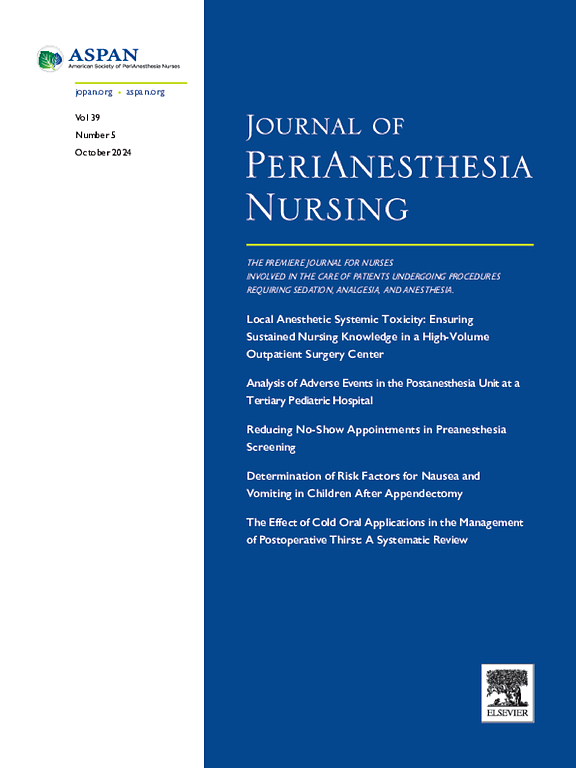Local Anesthetic Systemic Toxicity: Ensuring Sustained Nursing Knowledge in a High-Volume Outpatient Surgery Center
IF 1.6
4区 医学
Q2 NURSING
引用次数: 0
Abstract
Purpose
Local anesthetic systemic toxicity (LAST) is a low-frequency, high-risk event that can occur within minutes of a patient receiving a local anesthetic. The goals of this project were to standardize LAST care management across an academic medical center and sustain an improvement in nurses’ knowledge of how to recognize signs and symptoms of LAST and how to competently manage a LAST scenario.
Design
We used a quantitative design to accomplish the goals of the project.
Methods
Our interdisciplinary team developed a clinical practice guideline based on the LAST Checklist published by the American Society of Regional Anesthesia and Pain Medicine, and used a simulation scaffolded by multimodal education and system changes to ensure sustained knowledge. We measured improvement using a graded knowledge assessment as well as qualitative feedback.
Findings
Scores on the assessment increased from 4.76 to 6.34 (out of seven points) following the intervention and remained significantly higher than the baseline 9 months after the educational intervention (9-month score = 6.19, t = 2.99, P = .004). Nurses reported feeling more confident and knowledgeable following the intervention and requested to have regular sessions of the simulation. To sustain improvements, we developed a computer-based learning module. The module and simulation were integrated into nursing orientation and an annual competency.
Conclusions
While standardizing LAST care in accordance with evidence-based guidance is critical to patient safety due to its infrequent occurrence, nurses should consider implementing simulation supplemented with multimodal education and system changes to ensure sustained knowledge.
局麻药全身毒性:确保高流量门诊手术中心的持续护理知识。
目的:局麻药全身中毒(LAST)是一种低频率、高风险的事件,可在患者接受局麻药后几分钟内发生。本项目的目标是在一个学术医疗中心内实现 LAST 护理管理的标准化,并持续提高护士对如何识别 LAST 的体征和症状以及如何胜任 LAST 情景管理的认识:设计:我们采用定量设计来实现项目目标:我们的跨学科团队根据美国区域麻醉和疼痛医学会发布的 LAST 检查表制定了临床实践指南,并通过多模式教育和系统变革进行模拟训练,以确保持续掌握相关知识。我们使用分级知识评估和定性反馈来衡量改进情况:干预后,评估得分从 4.76 分提高到 6.34 分(满分 7 分),并且在教育干预 9 个月后仍显著高于基线得分(9 个月得分 = 6.19,t = 2.99,P = .004)。护士们表示在干预后感觉更有信心、知识更丰富,并要求定期进行模拟训练。为了保持改进,我们开发了一个基于计算机的学习模块。该模块和模拟被纳入护理指导和年度能力培训中:尽管根据循证指导规范 LAST 护理对患者安全至关重要,但由于其发生率较低,护士应考虑在实施模拟的同时辅以多模式教育和系统变革,以确保持续掌握相关知识。
本文章由计算机程序翻译,如有差异,请以英文原文为准。
求助全文
约1分钟内获得全文
求助全文
来源期刊

Journal of Perianesthesia Nursing
NURSING-
CiteScore
2.20
自引率
17.60%
发文量
279
审稿时长
90 days
期刊介绍:
The Journal of PeriAnesthesia Nursing provides original, peer-reviewed research for a primary audience that includes nurses in perianesthesia settings, including ambulatory surgery, preadmission testing, postanesthesia care (Phases I and II), extended observation, and pain management. The Journal provides a forum for sharing professional knowledge and experience relating to management, ethics, legislation, research, and other aspects of perianesthesia nursing.
 求助内容:
求助内容: 应助结果提醒方式:
应助结果提醒方式:


